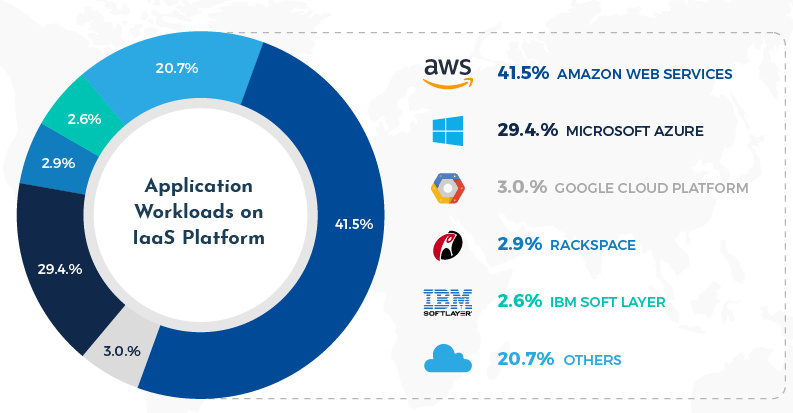Technology
The Impressive Stats Behind Amazon’s Dominance of the Cloud
To the average person, cloud computing must seem quite magical.
All at once, the cloud provides instant access to all of your data, photos, music, and applications, without you having to store any of that data locally. In fact, users can access the cloud from practically anywhere in the world, and across multiple devices and platforms.
Yet, this all happens without you actually seeing any visible infrastructure. With data now being created at record speeds, where the heck is all this information being physically stored?
The Rise of AWS
Even though you can’t see the vast infrastructure that runs the cloud, it does exist somewhere.
As today’s infographic from RapidValue shows, much of this infrastructure is owned and operated by Amazon, through its extremely profitable subsidiary of Amazon Web Services (AWS).
Here are the key stats on this dominant service that powers much of the internet today:

Amazon Web Services (AWS) quietly launched in 2002, and in a short time has been able to scale into the largest single player in cloud computing (IaaS, PaaS).
While it is a well-known name to software developers, AWS emerged on a more mainstream basis once its financials were separated from those of parent Amazon.com.
Even in 2018, AWS delivered most of Amazon’s operating income.
AWS By the Numbers
To understand the true scale of AWS, you need to look at the numbers.
- AWS has over 1 million active users in 190 countries
- AWS has 5x more deployed cloud infrastructure as their next 14 competitors combined
- Each day, AWS adds as much infrastructure as they used to run in total 7 years back
- Amazon S3 is designed to deliver 99.999999999% durability and scale past trillions of objects worldwide
- AWS partner, Netflix, accounts for up to one-third of Internet traffic during peak usage times
- AWS accounts for 41.5% of the public cloud market, bigger than Microsoft, Google, Rackspace, and IBM combined
Through incredible economies of scale, AWS has decreased its prices at least as many as 60 times since its launch – and despite this, AWS generated a whopping $26 billion in revenue for parent Amazon in 2018.
Technology
All of the Grants Given by the U.S. CHIPS Act
Intel, TSMC, and more have received billions in subsidies from the U.S. CHIPS Act in 2024.

All of the Grants Given by the U.S. CHIPS Act
This was originally posted on our Voronoi app. Download the app for free on iOS or Android and discover incredible data-driven charts from a variety of trusted sources.
This visualization shows which companies are receiving grants from the U.S. CHIPS Act, as of April 25, 2024. The CHIPS Act is a federal statute signed into law by President Joe Biden that authorizes $280 billion in new funding to boost domestic research and manufacturing of semiconductors.
The grant amounts visualized in this graphic are intended to accelerate the production of semiconductor fabrication plants (fabs) across the United States.
Data and Company Highlights
The figures we used to create this graphic were collected from a variety of public news sources. The Semiconductor Industry Association (SIA) also maintains a tracker for CHIPS Act recipients, though at the time of writing it does not have the latest details for Micron.
| Company | Federal Grant Amount | Anticipated Investment From Company |
|---|---|---|
| 🇺🇸 Intel | $8,500,000,000 | $100,000,000,000 |
| 🇹🇼 TSMC | $6,600,000,000 | $65,000,000,000 |
| 🇰🇷 Samsung | $6,400,000,000 | $45,000,000,000 |
| 🇺🇸 Micron | $6,100,000,000 | $50,000,000,000 |
| 🇺🇸 GlobalFoundries | $1,500,000,000 | $12,000,000,000 |
| 🇺🇸 Microchip | $162,000,000 | N/A |
| 🇬🇧 BAE Systems | $35,000,000 | N/A |
BAE Systems was not included in the graphic due to size limitations
Intel’s Massive Plans
Intel is receiving the largest share of the pie, with $8.5 billion in grants (plus an additional $11 billion in government loans). This grant accounts for 22% of the CHIPS Act’s total subsidies for chip production.
From Intel’s side, the company is expected to invest $100 billion to construct new fabs in Arizona and Ohio, while modernizing and/or expanding existing fabs in Oregon and New Mexico. Intel could also claim another $25 billion in credits through the U.S. Treasury Department’s Investment Tax Credit.
TSMC Expands its U.S. Presence
TSMC, the world’s largest semiconductor foundry company, is receiving a hefty $6.6 billion to construct a new chip plant with three fabs in Arizona. The Taiwanese chipmaker is expected to invest $65 billion into the project.
The plant’s first fab will be up and running in the first half of 2025, leveraging 4 nm (nanometer) technology. According to TrendForce, the other fabs will produce chips on more advanced 3 nm and 2 nm processes.
The Latest Grant Goes to Micron
Micron, the only U.S.-based manufacturer of memory chips, is set to receive $6.1 billion in grants to support its plans of investing $50 billion through 2030. This investment will be used to construct new fabs in Idaho and New York.
-

 Debt1 week ago
Debt1 week agoHow Debt-to-GDP Ratios Have Changed Since 2000
-

 Markets2 weeks ago
Markets2 weeks agoRanked: The World’s Top Flight Routes, by Revenue
-

 Countries2 weeks ago
Countries2 weeks agoPopulation Projections: The World’s 6 Largest Countries in 2075
-

 Markets2 weeks ago
Markets2 weeks agoThe Top 10 States by Real GDP Growth in 2023
-

 Demographics2 weeks ago
Demographics2 weeks agoThe Smallest Gender Wage Gaps in OECD Countries
-

 United States2 weeks ago
United States2 weeks agoWhere U.S. Inflation Hit the Hardest in March 2024
-

 Green2 weeks ago
Green2 weeks agoTop Countries By Forest Growth Since 2001
-

 United States2 weeks ago
United States2 weeks agoRanked: The Largest U.S. Corporations by Number of Employees













